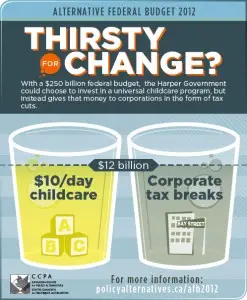As Canadians prepare for the release of the federal budget this month they should immerse themselves in the 2012 Alternative Federal Budget (AFB) that was launched today. Offering details of a Canada that “could be”, the Canadian Centre for Policy Alternatives (CCPA) has continued their annual assessment of the economy and offered a fresh perspective that focuses on the needs of Canadians. Titled, “A Budget for the Rest of Us”, the document puts people first while providing recommendations for financial allocations that will also boost the economy. The best of both worlds you could say.
The overall crux of this year’s AFB is to invest in people and services that support Canadians in order to stimulate the economy and reduce inequality. Reiterating that job creation remains low, especially when looking at youth employment, the AFB is the reverse to austerity measures that have proven in Europe to stagnate economies and harm progress.
A key feature in the AFB is the chapter on poverty and inequality. While the two are separate issues, there is much cross over and both continue to demand attention. Rising costs of basic needs such as food and housing, put pressure on many individuals and families who are frequently turning to debt to help with the burden. This is not a solution, and with further cuts to government jobs, funding for social services and health care (think of the Canada Health Transfer that will no longer be set to 6% in a few years time), what Canadians need involves financial support for everyone, not just the privileged few.
The AFB offers simple solutions that will increase revenue for the federal government, create over 300,000 jobs and support families and individuals with low-income. Investing in infrastructure and creating a more fair tax system will be integral to this plan. In terms of poverty one focus will be on the development of an federal action plan that is adequately funded and holds government to account. Some key recommendations for this are:
- Pass legislation that mandates the creation and support of a federal poverty action plan (such as Bill C-233)
- Establish new financial transfers to the provinces and territories in support of poverty reduction activities
- Increase the child tax benefit to $5,400 annually
- Re-establish a federal minimum wage at $11 and index it to inflation
- Create a national housing strategy and a national publicly funded childcare system
Poverty in Canada is often a story of low wages that can keep people trapped in a cycle of desperation with limited opportunity. Housing and child care are two of the highest expenses for families, and without government support it is hard to imagine how a person earning $10 an hour (or less) can afford both an apartment at market rates and a full week of childcare. Investing in people and services that support Canadians can help in a number of ways: childcare to ensure that parents will be able to enter the work force and contribute to the economy; affordable and adequate housing available for all Canadians so that no one lives in dire circumstances such as those found in Attawapiskat, Ontario last year; and education funds to offer opportunities for every person to go to school and better their future – not just those who can afford it.
Looking at the most recent government statistics, almost 1 in 10 Canadians are living in poverty, including 1 in 10 children. Recognizing the detrimental cost of poverty on society, and compelled by the profound injustice of its effects, many provinces and territories have developed, or are developing, poverty action plans. The AFB demonstrates that not only is a federal plan possible, but that poverty reduction goals are achievable and affordable.
New tax measures, such as a tax rate of 35% for those individuals with incomes over $250,000, would bring in $3.5 billion in revenue in 2012-13 alone. Another tax of 5% on financial sector profits (a ‘transaction tax’) would add another $5 billion to the pot. These are just two practical examples of recommendations in the AFB that would provide funding for such programs as the Canada Pension Plan or Old Age Security – two forms of assistance for seniors that have been targeted by the current government.
(See the Macro Economic and Fiscal Framework section of the AFB to understand the redistribution of revenue for services)
In Touch with Canadians
Money for healthcare, education and other crucial social services has dried up as corporate tax cuts and fiscal restraint take priority with this government. This is the opposite of what many Canadians want and need. This past January an Environics poll found that more than 8 out of 10 Canadians feel that the government needs to take steps to reduce the growing income gap. Another poll from 2008 organized by the CCPA on poverty found that 90% of respondents want the federal government to take a leadership role on poverty, and 89% feel that specific targets and timelines need to be established.
With a goal of reducing poverty by 25% in five years, and 75% in ten years, the AFB is in line with the swell of support among Canadians to end poverty. It also recognizes that investing in people is an investment in the economy, and that every person has a human right to food, housing and dignity. As the document states: “Persistent poverty represents a violation of economic and social rights enshrined in international law, and a squandering of human potential.”
In two weeks time the federal government will release a budget that was built on an undercurrent of austerity and spending cuts. In a misguided effort to assist a slowing economy, the government will likely miss the mark. Canadians require an increase in spending on social services, a reduction in income inequality, and leadership that recognizes the strength of investing in people.
Ending poverty is within reach, but will depend on the choices of our government.


